Generalized Asymmetry Parameters
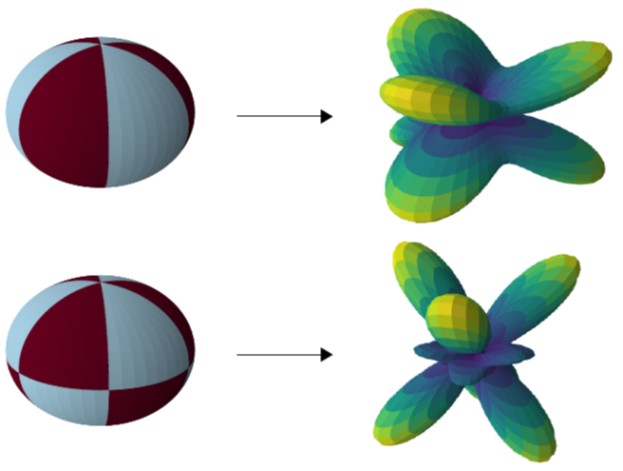 Internal motion of quantum mechanical systems is determined by superposition states.
Probing of electronic superposition states by ultrashort intense laser pulses leads to asymmetries
in the photoelectron emission due to the interference of linear and nonlinear transition
amplitudes. Conventional anisotropy and asymmetry parameters often fail to provide a
simple comprehensive tool to characterize the asymmetries in these cases. We have
proposed a new set of generalized asymmetry parameters, which provide intuitive
insights in the relative strength of the relevant processes. Application of the parameters
is tested via numerical solutions of the time dependent Schrodinger equation.
Internal motion of quantum mechanical systems is determined by superposition states.
Probing of electronic superposition states by ultrashort intense laser pulses leads to asymmetries
in the photoelectron emission due to the interference of linear and nonlinear transition
amplitudes. Conventional anisotropy and asymmetry parameters often fail to provide a
simple comprehensive tool to characterize the asymmetries in these cases. We have
proposed a new set of generalized asymmetry parameters, which provide intuitive
insights in the relative strength of the relevant processes. Application of the parameters
is tested via numerical solutions of the time dependent Schrodinger equation.
J. Venzke et al., Sci. Rep. 10, 161164 (2020).
JILA research highlight: Measuring Spinning Donuts
Anisotropy Reveals Interference
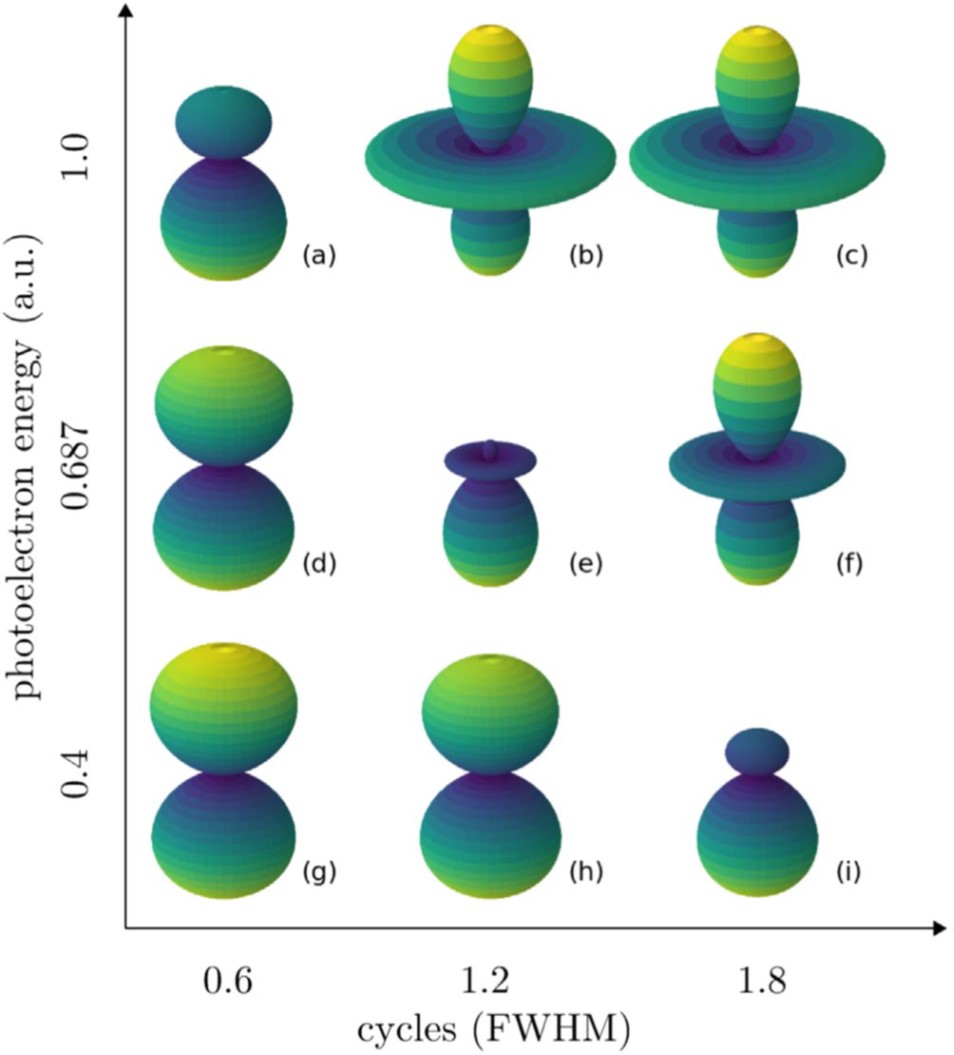 Due to the broadband spectrum of ultrashort pulses different pathways contribute
to the ionization of atoms. The competition between the contributions can be analyzed via the
photoionization angular distributions (see Figure) and the related anisotropy parameters as function
of the duration and peak intensity of the applied laser pulse. We have found that the transition
between one- and two-photon ionization can be observed via the even beta-parameters in
free-electron laser pulses and high-harmonic pulses without stabilization of the
carrier-to-envelope phase.
Due to the broadband spectrum of ultrashort pulses different pathways contribute
to the ionization of atoms. The competition between the contributions can be analyzed via the
photoionization angular distributions (see Figure) and the related anisotropy parameters as function
of the duration and peak intensity of the applied laser pulse. We have found that the transition
between one- and two-photon ionization can be observed via the even beta-parameters in
free-electron laser pulses and high-harmonic pulses without stabilization of the
carrier-to-envelope phase.
J. Venzke et al., J. Phys. B 53, 085602 (2020)
Finite-Range Attosecond Time Delays
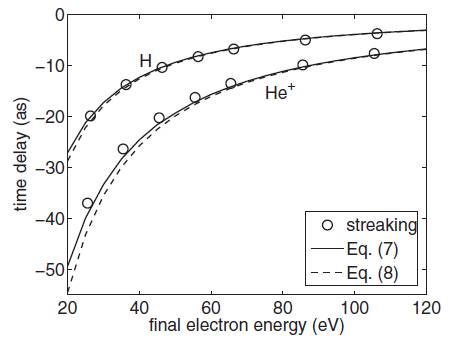 Measurements of the photoelectron momentum as a function of the delay between an ionizing XUV
and a superimposed infrared streaking pulse have recently revealed temporal offsets for
the electron emission from different shells of an atom. We have shown that results of related
numerical simulations and classical analysis (see Figure) can be interpreted as due to
the dynamics of the photoelectron in the Coulomb field of the parent ion and the streaking field.
The time delay is accumulated over a finite range in space, which the photoelectron probes after its transition into the
continuum until the streaking pulse ceases and can be approximately obtained via analytical expressions.
Through the effect of attochirp on the streaking time delay photoemission at frequencies near the Cooper minimum can be probed.
Measurements of the photoelectron momentum as a function of the delay between an ionizing XUV
and a superimposed infrared streaking pulse have recently revealed temporal offsets for
the electron emission from different shells of an atom. We have shown that results of related
numerical simulations and classical analysis (see Figure) can be interpreted as due to
the dynamics of the photoelectron in the Coulomb field of the parent ion and the streaking field.
The time delay is accumulated over a finite range in space, which the photoelectron probes after its transition into the
continuum until the streaking pulse ceases and can be approximately obtained via analytical expressions.
Through the effect of attochirp on the streaking time delay photoemission at frequencies near the Cooper minimum can be probed.
C. Goldsmith et al., Phys. Rev. A 96, 053410 (2017); J. Phys. B 51, 025601 (2018)
J. Su et al., Phys. Rev. A 87, 033420; 88, 023413 (2013); 89, 013404 (2014)
Review: C. Goldsmith et al., Appl. Sci. 9, 492 (2019)
Central Frequency of Few-Cycle Pulses
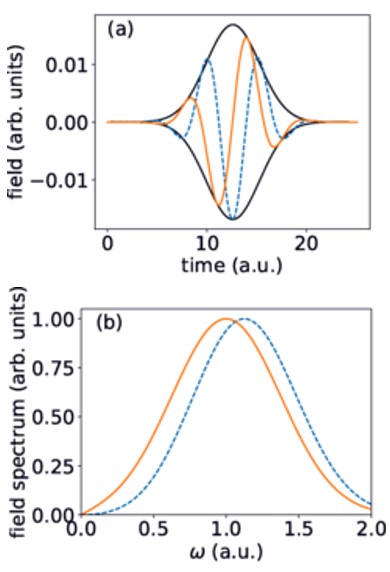 We have analyzed the role of the difference between the central frequencies of the
spectral distributions of the vector potential (solid lines) and the electric field (dashed lines)
of a short laser pulse. The frequency shift arises when the electric field is determined
as the derivative of the vector potential. We have derived an analytical estimate of the
frequency shift and analyzed its influence on various light induced processes.
Since observables depend on the frequency spectrum of the electric field, the shift
should be taken into account when setting the central frequency of the vector potential
to avoid potential misinterpretation of numerical results for processes induced by few-cycle pulses.
We have analyzed the role of the difference between the central frequencies of the
spectral distributions of the vector potential (solid lines) and the electric field (dashed lines)
of a short laser pulse. The frequency shift arises when the electric field is determined
as the derivative of the vector potential. We have derived an analytical estimate of the
frequency shift and analyzed its influence on various light induced processes.
Since observables depend on the frequency spectrum of the electric field, the shift
should be taken into account when setting the central frequency of the vector potential
to avoid potential misinterpretation of numerical results for processes induced by few-cycle pulses.
J. Venzke, T. Joyce et al., Phys. Rev. A 98, 063409 (2018)
Isolated Circulary Polarized Attosecond Pulses
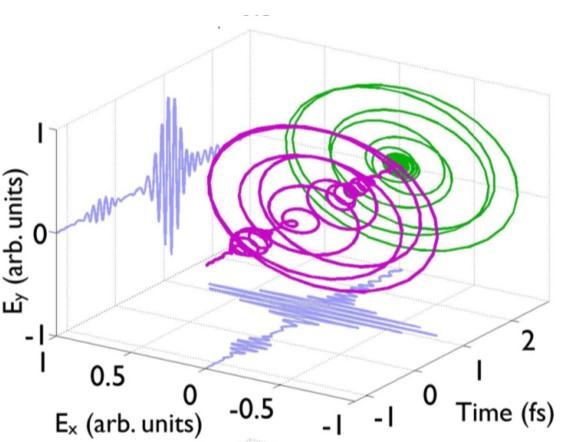 Two techniques for the efficient production of circularly polarized high harmonics have been
demonstrated in the Kapteyn-Murnane group at JILA, leading to the generation and reconstruction
of some of the most complex coherent light fields ever produced.
Our theoretical analysis of these experiments has further given rise to the proposal
of schemes for the production of isolated attosecond pulses of pure circular polarization (see Figure).
In a set-up with two noncollinear, counter-rotating circularly polarized pulses the
isolation can be either achieved by restricting the driver pulse duration to a few cycles or by
temporally delaying the two crossed driver pulses. The isolation of an attosecond pulse with full control
over the polarization state has been recently demonstrated in the experiment by our collaborators -
in collaboration with M. Murnane and H. Kapteyn (JILA), L. Plaja and I. Sola
(Universidad Salamanca, Spain) and M.-C. Chen (National Taiwan University).
Two techniques for the efficient production of circularly polarized high harmonics have been
demonstrated in the Kapteyn-Murnane group at JILA, leading to the generation and reconstruction
of some of the most complex coherent light fields ever produced.
Our theoretical analysis of these experiments has further given rise to the proposal
of schemes for the production of isolated attosecond pulses of pure circular polarization (see Figure).
In a set-up with two noncollinear, counter-rotating circularly polarized pulses the
isolation can be either achieved by restricting the driver pulse duration to a few cycles or by
temporally delaying the two crossed driver pulses. The isolation of an attosecond pulse with full control
over the polarization state has been recently demonstrated in the experiment by our collaborators -
in collaboration with M. Murnane and H. Kapteyn (JILA), L. Plaja and I. Sola
(Universidad Salamanca, Spain) and M.-C. Chen (National Taiwan University).
P.-C. Huang et al., Nat. Photon. 12, 349 (2018)
C. Hernandez-Garcia et al., Phys. Rev. A 93, 043855 (2016)
C. Chen et al., Science Adv. 2, E1501333 (2016)
T. Fan et al., Proc. Nat. Acad. Sci. 112, 14206 (2015)
D.D. Hickstein et al., Nat. Photon. 9, 743 (2015)
JILA research highlight: A Collaborative Mastery of X-Rays, Reconstruction, The Guiding Light
Delayed Resonant Two-Photon Ionization
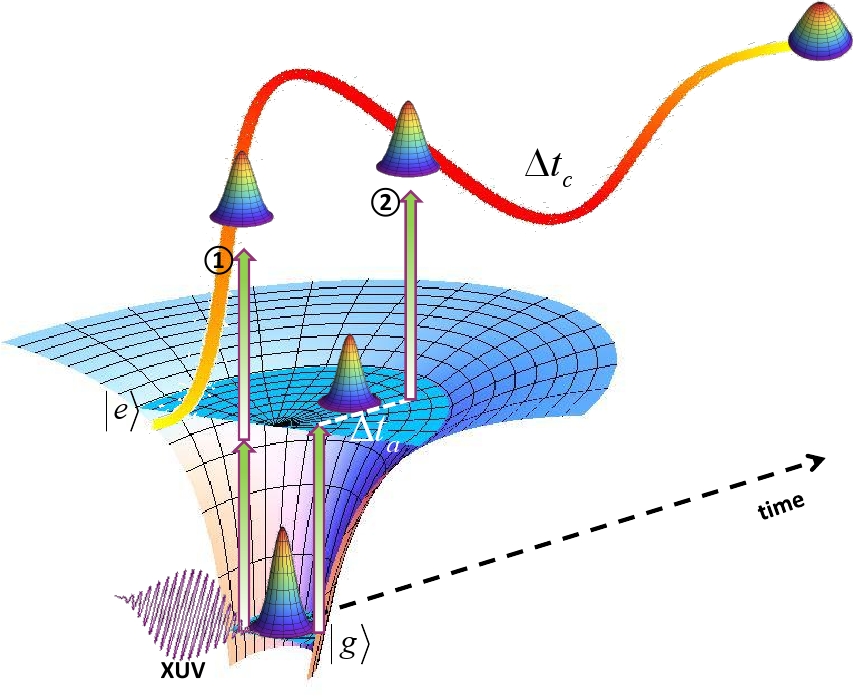 The advancements in the understanding of the attosecond streaking camera technique
(see, e.g., our work below) opens the perspective to retrieve time-resolved
information about the dynamics of electrons during transitions inside an atom or molecule.
As a prototype example, we have shown how the time delay in resonant two-photon ionization
as compared to the instantaneous transition from the ground state to the continuum in a
nonresonant process can be retrieved from numerical results for attosecond streaking traces.
Using perturbative analysis we systematically investigated the absorption time delay through an intermediate resonance.
The advancements in the understanding of the attosecond streaking camera technique
(see, e.g., our work below) opens the perspective to retrieve time-resolved
information about the dynamics of electrons during transitions inside an atom or molecule.
As a prototype example, we have shown how the time delay in resonant two-photon ionization
as compared to the instantaneous transition from the ground state to the continuum in a
nonresonant process can be retrieved from numerical results for attosecond streaking traces.
Using perturbative analysis we systematically investigated the absorption time delay through an intermediate resonance.
C. Goldsmith et al., J. Phys. B 51, 155602 (2018); J. Su et al., Phys. Rev. Lett. 113, 263002 (2014)
JILA research highlight: An Ultrafast Photoelectric Adventure
Attosecond High Harmonic Spectroscopy
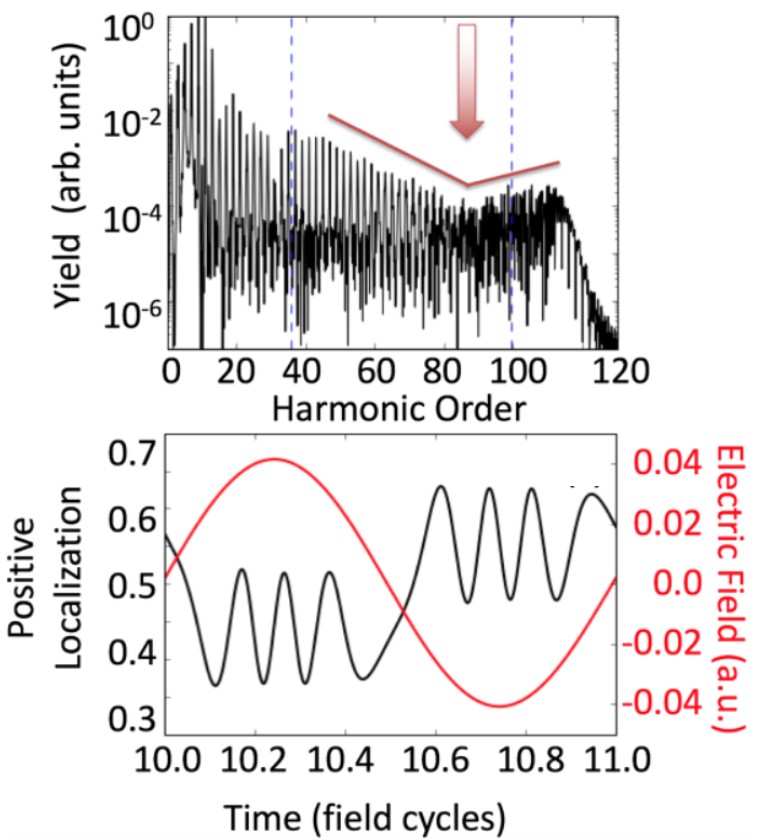 High harmonic generation is a nonlinear process that involves the release of an electron wave packet,
its laser-driven propagation in the continuum followed by its recombination. Each of these steps
occurs on a femto- or sub-femtosecond time span and, hence, high harmonic generation provides a
spectroscopic tool to resolve electron dynamics on the attosecond time scale. Our analysis shows
that the nonadiabatic electron motion inside a molecule over one cycle of the driving laser
field (lower panel, see also below) imprints a minimum in the generated high harmonic spectrum (upper panel).
Even changes to the nonadiabatic dynamics from one field cycle to the next can be traced in the
emitted signal.
High harmonic generation is a nonlinear process that involves the release of an electron wave packet,
its laser-driven propagation in the continuum followed by its recombination. Each of these steps
occurs on a femto- or sub-femtosecond time span and, hence, high harmonic generation provides a
spectroscopic tool to resolve electron dynamics on the attosecond time scale. Our analysis shows
that the nonadiabatic electron motion inside a molecule over one cycle of the driving laser
field (lower panel, see also below) imprints a minimum in the generated high harmonic spectrum (upper panel).
Even changes to the nonadiabatic dynamics from one field cycle to the next can be traced in the
emitted signal.
M.R. Miller et al., Phys. Rev. A 93, 013406 (2016); Mol. Phys. 115, 1758 (2017).
Nonadiabatic Attosecond Electron Dynamics
 Attosecond laser technology is expected to provide movies
of the ultrafast quantum world of electrons in atoms, molecules and other materials.
We have shown that an intense laser field can drive the electron in between the
two protons of the hydrogen molecular ion nonadiabatically.
This leads to the unexpected
result that the electron may not leave the molecule through the tunnel exit
when the field of the laser is
strongest, in contrast to the predictions of popular quasistatic ionization pictures.
In contrast, our numerical results have shown that there are multiple bursts of electron ejection
at low field strengths in the oscillating electric field of a laser (see Figure).
This nonadiabatic attosecond intramolecular dynamics can be mapped onto
the momenta of the electron in the continuum or the high harmonic spectrum where it becomes observable
- in collaboration with R. Dörner (Universität Frankfurt, Germany).
Attosecond laser technology is expected to provide movies
of the ultrafast quantum world of electrons in atoms, molecules and other materials.
We have shown that an intense laser field can drive the electron in between the
two protons of the hydrogen molecular ion nonadiabatically.
This leads to the unexpected
result that the electron may not leave the molecule through the tunnel exit
when the field of the laser is
strongest, in contrast to the predictions of popular quasistatic ionization pictures.
In contrast, our numerical results have shown that there are multiple bursts of electron ejection
at low field strengths in the oscillating electric field of a laser (see Figure).
This nonadiabatic attosecond intramolecular dynamics can be mapped onto
the momenta of the electron in the continuum or the high harmonic spectrum where it becomes observable
- in collaboration with R. Dörner (Universität Frankfurt, Germany).
M.R. Miller et al., Phys. Rev. A 93, 013406 (2016)
M. Odenweller et al., Phys. Rev. Lett. 107, 143004 (2011)
N. Takemoto and A. Becker, Phys. Rev. Lett. 105, 203004 (2010)
F. He et al., Phys. Rev. Lett. 101, 213002 (2008)
Reviews:
M.R. Miller et al., Optica 3, 259-269 (2016)
A. Becker et al., in Attosecond Physics: Attosecond Measurements and Control
of Physical Systems, Springer Series in Optical Sciences, Vol. 177
(Springer, Berlin - Heidelberg, 2013) p. 207-229
Discussion of our work with the group of R. Dörner in NewScientist: Attoclock turns electrons into movie stars
JILA research highlight: Quantum Body Swapping
Towards Zeptosecond X-ray Waveforms
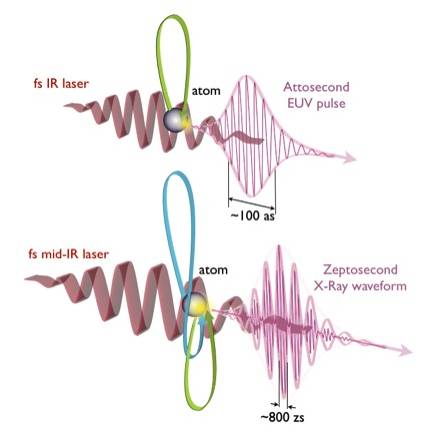 The Kapteyn-Murnane group at JILA has demonstrated the generation of bright coherent keV X-rays from a table-top mid-infrared
laser source using the process of high harmonic generation. In this process
the energy of more than 5000 mid-infrared photons is converted into the energy of one X-ray photon.
We have shown theoretically that the temporal structure of these high harmonic pulses differs
from those generated with near-infrared pulses. In particular, we have found that, although the
total width of the X-ray bursts spans femtoseconds, the pulse exhibits
a sub-attosecond (1 as = 10-18 s) structure
due to the interference of high harmonic emission from multiple rescatterings of the electron
wave packet with the ion -
in collaboration with L. Plaja (Universidad Salamanca, Spain) and M. Murnane and H. Kapteyn (JILA).
The Kapteyn-Murnane group at JILA has demonstrated the generation of bright coherent keV X-rays from a table-top mid-infrared
laser source using the process of high harmonic generation. In this process
the energy of more than 5000 mid-infrared photons is converted into the energy of one X-ray photon.
We have shown theoretically that the temporal structure of these high harmonic pulses differs
from those generated with near-infrared pulses. In particular, we have found that, although the
total width of the X-ray bursts spans femtoseconds, the pulse exhibits
a sub-attosecond (1 as = 10-18 s) structure
due to the interference of high harmonic emission from multiple rescatterings of the electron
wave packet with the ion -
in collaboration with L. Plaja (Universidad Salamanca, Spain) and M. Murnane and H. Kapteyn (JILA).
C. Hernandez-Garcia et al., Phys. Rev. Lett. 111, 033002 (2013)
T. Popmintchev et al., Science 91, 1287 (2012)
featured by APS, IOP Physics World and in Nature
JILA research highlights: X-ray Visionaries, Back to the Future, Life in the Fast Lane, The Long and the Short of Soft X-rays
Past Projects
Instantaneous Stark Shifts
We have proposed a method to use attosecond pulse technology for observing
instantaneous Stark shifts of atomic states in an oscillating intense laser field.
F. He et al., J. Phys. B 44, 211001 (2011)
Coherent Control Schemes in the Time Domain
We have provided a complementary view on few-photon coherent control schemes
by analyzing the electron dynamics in the time domain.
S. Chen et al., Phys. Rev. A 82, 013414 (2010)
J. Su et al., Phys. Rev. A 84, 065402 (2011)
Attosecond Coherent Control
We have studied how the electron in the dissociating hydrogen molecular
ion can be localized with high probability at one of the two nuclei using
two time-delayed ultrashort intense laser pulses.
F. He et al. Phys. Rev. Lett. 99, 083002 (2007)
F. He and A. Becker, J. Phys. B 41, 074017 (2008)
F. He et al. J. Phys. B 41, 081003 (2008)